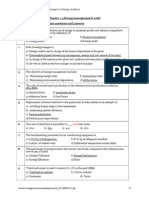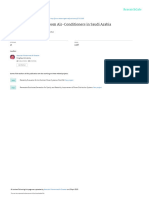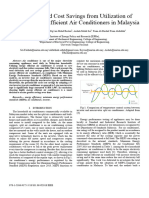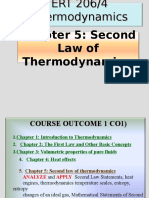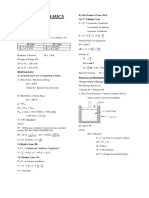Air Conditioner Energy Efficiency Benchmark 2021: Government of The People's Republic of Bangladesh
Air Conditioner Energy Efficiency Benchmark 2021: Government of The People's Republic of Bangladesh
Uploaded by
SharmilaCopyright:
Available Formats
Air Conditioner Energy Efficiency Benchmark 2021: Government of The People's Republic of Bangladesh
Air Conditioner Energy Efficiency Benchmark 2021: Government of The People's Republic of Bangladesh
Uploaded by
SharmilaOriginal Title
Copyright
Available Formats
Share this document
Did you find this document useful?
Is this content inappropriate?
Copyright:
Available Formats
Air Conditioner Energy Efficiency Benchmark 2021: Government of The People's Republic of Bangladesh
Air Conditioner Energy Efficiency Benchmark 2021: Government of The People's Republic of Bangladesh
Uploaded by
SharmilaCopyright:
Available Formats
Government of the people’s Republic of Bangladesh
Sustainable and Renewable Energy Development Authority (SREDA)
10th Floor, IEB Building, Ramna, Dhaka
www.sreda.gov.bd
Air Conditioner Energy Efficiency Benchmark 2021
Background:
This Document identifies current technologies that is available in Market and used in buildings in
Bangladesh and recommends Alternative energy-efficient cooling technology best suited to the
country.
Purpose:
The purpose of this Document to identify Average Energy Efficiency Benchmark for Air
Conditioner, So that it can be used to prepare Labeling Criteria for Air conditioner.
Methodology:
The information on energy-efficient equipment specifications and costs is collected from both
primary
and secondary sources. The primary sources includes onsite market verification, interviews, and
Sales data of manufacturers or the association of the equipment manufacturers. Some of the import
data is collected from the National Board of Revenue (NBR) to cross-verify the market share of
the different equipment manufacturers. The secondary sources of data is collected mainly from the
website of the equipment manufacturers. In addition, various research reports, news articles, and
similar previous studies by SREDA and other institutions will provide secondary data.
Scope:
This Document is deals with Refrigeration and Air conditioning unit used in residential sector.
This includes Unitary Air Conditioner like Split type Air Conditioner, Window Air Conditioner
etc.
Energy Efficiency Component:
The possible improvements in energy efficiency depend on the unit under consideration, the
already Existing Energy Efficiency Ratio (EER), the refrigerant, climatic conditions and cooling
capacity. The Ideal refrigeration cycle, assuming constant load, infinite-sized heat exchangers and
100% efficient Compressors, has a Coefficient of Performance (COP)
Air Conditioner Market:
Single split-type ACs are the most widely used UAC in Bangladesh. Among them, ACs with
capacities
of 12,000, 18,000 and 24,000 BTU-hour are mostly used in residential buildings and offices.
According to Bangladesh´s Refrigerator and Air Conditioning Manufacturing and Exporters
Association, around 420,000 single split ACs were sold on the local market, where the capacity of
18,000 BTU accounted for more than 60% of the local sales. The growth rate of the UAC market
(excluding VRF) is shown in Figure 1.
Figure 1: UAC ( without VRF) market size and growth rate in Bangladesh
Through a market survey, it was found that AC units using R22 and R410A refrigerants still
dominate the Bangladeshi market. However, the trend is moving toward R410A, due to the reduced
R22 import quota set by the DoE. Local manufacturers which are the stakeholders of the
retrofitting project under MLF projects are working to develop R290-based ACs for capacities of
12,000 BTU and 18,000 BTU. For capacities above 18,000 BTU such as 24,000 BTU, 48,000
BTU and 60,000 BTU, manufacturers are working to develop and establish R32-based ACs due
to the (currently) limited charge allowed for R290 flammable refrigerants. R32 has a relatively
low GWP (GWP=675) compared to conventional refrigerants but is mildly flammable. UNEP and
UNDP facilitate various trainings for local technicians to be able to handle mildly flammable
refrigerants in ACs. Currently, the main challenge for local manufacturers is the procurement of
R290-based compressors.
The R290 split ACs can achieve an EER between 4 and 5 for cooling capacities of 18,000 BTU
and a SEER between 6 and 7 for cooling capacities between 9,000 and 12,000 BTU. Bangladesh’s
best available R32 split AC appliances achieve an average EER of 3.6, a slightly higher value
compared to available AC units in other countries and regions.
Findings of Market Research:
It was found that AC units using R22 and R410A refrigerants still dominate the
Bangladeshi market
Price difference between inverter and non-inverter models are minimal.
Price difference reflects more of other functional differences like air refreshing, ambient
controlling, space-saving design and others (there are cases where non-inverter-controlled
models are more expensive than the inverter-controlled ones).
Energy saving features by inverter-controlling is not reflected in EER figures.
Almost all of the brands are already offering both inverter-controlled and non-inverter-
controlled selections.
Benchmark for Air Conditioner for Bangladesh
Below Table depict the average benchmark for Air Conditioner Performance based on Energy
Efficiency ratio.
No Capacity Type Energy Efficiency Ratio COP
(TON) (EER)
01 1-2 Split type 3.64 3.146
02 2- 4.5 Split 3.05 2.9
03 Over 4.5 Multi Split, VRF 3.98 3.67
Recommendation
EER (or COP) is an indicator to measure and compare the energy efficiency performance
at almost continuous full load, therefore the benefit of inverter-controlling will not be
reflected. EER may be used as a criterion for minimum standard (say over 2.9), but will
have minimal effect to the market.
An indicator taking into account the seasonal fluctuation of temperature should be
introduced. Regional Seasonal Energy Efficiency Ratio (SEER) or Other International
standard energy consumption may be referred to as the examples.
You might also like
- Energy Calculations & Problem Solving Sourcebook: A Practical Guide for the Certified Energy Manager ExamFrom EverandEnergy Calculations & Problem Solving Sourcebook: A Practical Guide for the Certified Energy Manager ExamNo ratings yet
- Chapter - 4-Simple Vapour Compression Refrigeration SystemDocument141 pagesChapter - 4-Simple Vapour Compression Refrigeration SystemMohamed Al-Odat50% (2)
- IECC 2015 - GA 2020 Supplements and AmendmentsDocument52 pagesIECC 2015 - GA 2020 Supplements and AmendmentsSam HarveyNo ratings yet
- Industry Articles - YaskawaDocument10 pagesIndustry Articles - YaskawaanuragpugaliaNo ratings yet
- Energy Efficiency Terms of Refrigeration SystemsDocument3 pagesEnergy Efficiency Terms of Refrigeration SystemsDan NugrahaNo ratings yet
- Chapter 8Document6 pagesChapter 8Mohamed SalahNo ratings yet
- qt7m9250pd NosplashDocument30 pagesqt7m9250pd NosplashVitsakorn NabhirongNo ratings yet
- Assumptions For Chiller EfficiencyDocument1 pageAssumptions For Chiller EfficiencyEdmund YoongNo ratings yet
- MGMT 7 Energy Conservation and Fire SafetyDocument17 pagesMGMT 7 Energy Conservation and Fire SafetybaneshNo ratings yet
- Journal of Building Engineering: M. Krarti, Nicholas HowarthDocument12 pagesJournal of Building Engineering: M. Krarti, Nicholas HowarthFelimban AhmadNo ratings yet
- HVAC: Packaged Rooftop Air Conditioners: What Are The Options?Document5 pagesHVAC: Packaged Rooftop Air Conditioners: What Are The Options?Steven WeiNo ratings yet
- 1.3 Energy Management and Audit - Revised (Table Format)Document9 pages1.3 Energy Management and Audit - Revised (Table Format)Gajanan JagtapNo ratings yet
- AC REGULATIONS - BAHRAIN-FinalDocument20 pagesAC REGULATIONS - BAHRAIN-FinalRamesh K KarthickNo ratings yet
- Critique of The Design and Operation of Sustainable Air-Cooled Chillers in Commercial BuildingsDocument26 pagesCritique of The Design and Operation of Sustainable Air-Cooled Chillers in Commercial BuildingsKailas NimbalkarNo ratings yet
- Case Study in Brazil - 03Document37 pagesCase Study in Brazil - 03Jhoana MendozaNo ratings yet
- Heat - Energy Recovery Ventilators (HRVS) and (ERVs) - ENERGY STAR Technical SpecificationsDocument14 pagesHeat - Energy Recovery Ventilators (HRVS) and (ERVs) - ENERGY STAR Technical Specificationshali10No ratings yet
- Energy Management Study of Boiler in An Alcohol Refining Factory in EthiopiaDocument18 pagesEnergy Management Study of Boiler in An Alcohol Refining Factory in EthiopiaTJPRC PublicationsNo ratings yet
- Kirloskar Pneumatic Co. Ltd. - CoMDocument4 pagesKirloskar Pneumatic Co. Ltd. - CoMForceFieldNo ratings yet
- Section 15700 - Heating, Ventilating, & Air Conditioning EquipmentDocument7 pagesSection 15700 - Heating, Ventilating, & Air Conditioning EquipmentAnonymous NMytbMiDNo ratings yet
- TR Air Con 06Document43 pagesTR Air Con 06junnelNo ratings yet
- Efficiency Improvement Oppertunities With BLDC Fan PDFDocument14 pagesEfficiency Improvement Oppertunities With BLDC Fan PDFjust_4_u_dear_in9549No ratings yet
- CLASP HarmonizationStudyP2 Ch4Document4 pagesCLASP HarmonizationStudyP2 Ch4Gopinath RamalingamNo ratings yet
- EER Saudi Arabia - ScientificResearchDocument9 pagesEER Saudi Arabia - ScientificResearchEduardoNo ratings yet
- Energy Conservation in Commercial Buildings by Energy Management SystemDocument9 pagesEnergy Conservation in Commercial Buildings by Energy Management SystemRAMESHNo ratings yet
- PBRS - Resourceful EnergyDocument31 pagesPBRS - Resourceful EnergyMohamed ShiraziNo ratings yet
- Energy Efficiency in Sugar Plant Steam and Power Generation PDFDocument6 pagesEnergy Efficiency in Sugar Plant Steam and Power Generation PDFSrikanth SriNo ratings yet
- FTKM-PVMK LRDocument12 pagesFTKM-PVMK LRafkar.mep.ajmNo ratings yet
- GrasimDocument10 pagesGrasimGaurav SinghNo ratings yet
- 25-01-10 Networking Event EMS FinalDocument41 pages25-01-10 Networking Event EMS FinalajeeshsivanNo ratings yet
- Seasonal Energy Efficien..Document6 pagesSeasonal Energy Efficien..Karthikeyan SankarrajanNo ratings yet
- Danfoss AHU - 5Document16 pagesDanfoss AHU - 5J.P. PazaNo ratings yet
- Report On Air Conditioners 2 PDFDocument24 pagesReport On Air Conditioners 2 PDFKhay SaadNo ratings yet
- 1 s2.0 S030142151830692X MainDocument16 pages1 s2.0 S030142151830692X MainFernando CostaNo ratings yet
- The Impact That DCMEV Has On A Typical Apartment Layout of A Generic HA When Compared To MVHRDocument14 pagesThe Impact That DCMEV Has On A Typical Apartment Layout of A Generic HA When Compared To MVHRmartin.bullNo ratings yet
- Equipment Optimization: Introduction/ObjectivesDocument3 pagesEquipment Optimization: Introduction/ObjectivesSehry SyedNo ratings yet
- Intelligent Control of Electric Vehicle Air Conditioning System Based On DeepDocument19 pagesIntelligent Control of Electric Vehicle Air Conditioning System Based On DeepRAJ KOKARENo ratings yet
- 2 - Electrical Energy Audit PDFDocument10 pages2 - Electrical Energy Audit PDFPrachi BhaveNo ratings yet
- Fan Efficiency ArticlesDocument12 pagesFan Efficiency ArticlesRami GhanemNo ratings yet
- Next Generation RSeries 200-250kW WhoteDocument5 pagesNext Generation RSeries 200-250kW WhotedoddrodNo ratings yet
- QS SASO 2663 E Final Draft PDFDocument22 pagesQS SASO 2663 E Final Draft PDFMahjoub AmriNo ratings yet
- HighPerformanceCommercial Buildings - BrochureDocument8 pagesHighPerformanceCommercial Buildings - BrochureAmbar MittalNo ratings yet
- Cop and EerDocument3 pagesCop and Eerطاہر رضاNo ratings yet
- Final Report BeeDocument118 pagesFinal Report BeeSantosh DevadeNo ratings yet
- Electricity and Cost Savings From Utilization of Highly Energy Efficient Air Conditioners in Malaysia-2018Document4 pagesElectricity and Cost Savings From Utilization of Highly Energy Efficient Air Conditioners in Malaysia-2018Leo Le GrisNo ratings yet
- SPE 93132 Energy Conservation Through The Implementation of Cogeneration and Grid InterconnectionDocument4 pagesSPE 93132 Energy Conservation Through The Implementation of Cogeneration and Grid Interconnectionmsmsoft90No ratings yet
- Automobile ManufacturingDocument50 pagesAutomobile ManufacturingvibraaNo ratings yet
- AirCon Best PracticeDocument15 pagesAirCon Best Practicesimon0% (1)
- Cooling Efficiency ModificationsDocument5 pagesCooling Efficiency Modificationsnareshbv749No ratings yet
- Energy Efficient PidDocument7 pagesEnergy Efficient PidLij Girmachew Tekel HawariatNo ratings yet
- CEP - SavingDocument6 pagesCEP - SavingManoj UpadhyayNo ratings yet
- EPBD Guidance 2024Document18 pagesEPBD Guidance 2024Ricardo FigueiraNo ratings yet
- Small Scale Organic Rankine Cycle (ORC) A Techno-Economic ReviewDocument26 pagesSmall Scale Organic Rankine Cycle (ORC) A Techno-Economic ReviewJoao MinhoNo ratings yet
- Energy ManagementDocument10 pagesEnergy ManagementPratik RanjanNo ratings yet
- Energy Efficiency Best PracticeDocument35 pagesEnergy Efficiency Best PracticewatiNo ratings yet
- Standard Refinery Fuel TonsDocument2 pagesStandard Refinery Fuel TonsPinjala Anoop100% (4)
- Standard Refinery Fuel TonsDocument2 pagesStandard Refinery Fuel TonsPinjala AnoopNo ratings yet
- Energy Management and Efficiency for the Process IndustriesFrom EverandEnergy Management and Efficiency for the Process IndustriesNo ratings yet
- Modeling, Analysis and Optimization of Process and Energy SystemsFrom EverandModeling, Analysis and Optimization of Process and Energy SystemsNo ratings yet
- Oil companies and the energy transitionFrom EverandOil companies and the energy transitionNo ratings yet
- Energy and Thermal Management, Air-Conditioning, and Waste Heat Utilization: 2nd ETA Conference, November 22-23, 2018, Berlin, GermanyFrom EverandEnergy and Thermal Management, Air-Conditioning, and Waste Heat Utilization: 2nd ETA Conference, November 22-23, 2018, Berlin, GermanyChristine JuniorNo ratings yet
- Quality and Reliability Aspects in Nuclear Power Reactor Fuel Engineering: Guidance and Best Practices to Improve Nuclear Fuel Reliability and Performance in Water Cooled ReactorsFrom EverandQuality and Reliability Aspects in Nuclear Power Reactor Fuel Engineering: Guidance and Best Practices to Improve Nuclear Fuel Reliability and Performance in Water Cooled ReactorsNo ratings yet
- P2.025.12 UK v2 KopiDocument9 pagesP2.025.12 UK v2 KopiSharmilaNo ratings yet
- CG 00788Document37 pagesCG 00788SharmilaNo ratings yet
- 023 Anette Michel Final Paper SDocument12 pages023 Anette Michel Final Paper SSharmilaNo ratings yet
- Clasp UpdateDocument31 pagesClasp UpdateSharmilaNo ratings yet
- Full Text 02Document220 pagesFull Text 02SharmilaNo ratings yet
- EGYPRADocument63 pagesEGYPRASharmilaNo ratings yet
- AC Test Methods Report Final V2 Incl JP KODocument42 pagesAC Test Methods Report Final V2 Incl JP KOSharmilaNo ratings yet
- 19R V3 Ch07 ODS SubstitutesDocument48 pages19R V3 Ch07 ODS SubstitutesSharmilaNo ratings yet
- En 2098667Document21 pagesEn 2098667SharmilaNo ratings yet
- VERTECO NEOPERL Catalogue 2019Document16 pagesVERTECO NEOPERL Catalogue 2019SharmilaNo ratings yet
- InputsDocument57 pagesInputsSharmilaNo ratings yet
- 1 s2.0 S0360132318305614 MainDocument21 pages1 s2.0 S0360132318305614 MainSharmilaNo ratings yet
- Formal Report TemplateDocument3 pagesFormal Report TemplateSharmilaNo ratings yet
- Ieqp1 DyaDocument1 pageIeqp1 DyaSharmilaNo ratings yet
- Building Standard Wellv2Document380 pagesBuilding Standard Wellv2SharmilaNo ratings yet
- T4b0400000b0012pdfe PDFDocument58 pagesT4b0400000b0012pdfe PDFSharmilaNo ratings yet
- 018113-Sustainable Design requirements-LEEDv4Document15 pages018113-Sustainable Design requirements-LEEDv4SharmilaNo ratings yet
- CI109001 Newsletterpubs AbasustainabilityDocument10 pagesCI109001 Newsletterpubs AbasustainabilitySharmilaNo ratings yet
- Tutorial Problems-Ch 5Document36 pagesTutorial Problems-Ch 5nonstopforever9266No ratings yet
- SME MCQ All UTDocument306 pagesSME MCQ All UTliveNo ratings yet
- Iea SHC Task68 Report Rb1Document27 pagesIea SHC Task68 Report Rb1Kapil NarulaNo ratings yet
- Refrigeration and Air Conditioning With Take Home TestDocument14 pagesRefrigeration and Air Conditioning With Take Home Testhim100% (1)
- Abstract Air Con Trainer UnitDocument11 pagesAbstract Air Con Trainer UnitVirneDalisayNo ratings yet
- Refrigeration Unit: Muhammad Tarmizi Bin Abdul Murad (2019883632)Document18 pagesRefrigeration Unit: Muhammad Tarmizi Bin Abdul Murad (2019883632)Lehbron JemsNo ratings yet
- 1 s2.0 S2352484722001731 MainDocument20 pages1 s2.0 S2352484722001731 Mainrehan2khanNo ratings yet
- Reduce Your Energy Bill - Increase Your Confidence: Air-Cooled Liquid Chillers and Heat Pumps 40-160 KWDocument6 pagesReduce Your Energy Bill - Increase Your Confidence: Air-Cooled Liquid Chillers and Heat Pumps 40-160 KWGonADFNo ratings yet
- Lab Report 560751c42519eDocument16 pagesLab Report 560751c42519eNadiaNo ratings yet
- SBS5311 1718 Lab Refrigeration Cycle PDFDocument6 pagesSBS5311 1718 Lab Refrigeration Cycle PDFرولا العمرNo ratings yet
- Country Update Report For Kenya 2015-2019Document16 pagesCountry Update Report For Kenya 2015-2019innocent ndikubwimanaNo ratings yet
- Hey 22Document6 pagesHey 22AM CruzNo ratings yet
- Thermodynamic Modelling of A Single-Effect Absorption CycleDocument14 pagesThermodynamic Modelling of A Single-Effect Absorption CyclealbertoNo ratings yet
- PHD Thesis - Anthony Lo - 9 Dec 2014Document264 pagesPHD Thesis - Anthony Lo - 9 Dec 2014Hiei ArshavinNo ratings yet
- Split Type AcuDocument40 pagesSplit Type AcuKristine Ann ReclosadoNo ratings yet
- 30RAPDocument108 pages30RAPIvanovich RodriguezNo ratings yet
- 2014 10 - Om 3 2015 - LCP HP PDFDocument48 pages2014 10 - Om 3 2015 - LCP HP PDFProjects - Simode ConsultingNo ratings yet
- Thermo Acoustic RefrigerationDocument23 pagesThermo Acoustic RefrigerationSujitNo ratings yet
- Design and Performance Analysis of Water Chiller - A ResearchDocument8 pagesDesign and Performance Analysis of Water Chiller - A ResearchDiyar NezarNo ratings yet
- Trigeneration Unit by Dusan MedvedDocument4 pagesTrigeneration Unit by Dusan MedvedTofanB100% (1)
- Fujitsu-General Asyg18-30 LFC 2015 1Document1 pageFujitsu-General Asyg18-30 LFC 2015 1Anonymous nYYK74x7No ratings yet
- Chapter 5: Second Law of ThermodynamicsDocument30 pagesChapter 5: Second Law of ThermodynamicsMetalAnand ChelliahNo ratings yet
- Thermodynamics FormulasDocument3 pagesThermodynamics FormulasZack D. SnutssNo ratings yet
- Clivet Pack 31 MaliDocument56 pagesClivet Pack 31 MaliuroslNo ratings yet
- Energy Efficiency For The Transcritical Compression CO2 Cycle With The Use of The Ejector As The Firts Stage of The CompressionDocument9 pagesEnergy Efficiency For The Transcritical Compression CO2 Cycle With The Use of The Ejector As The Firts Stage of The CompressionOnofreHalberNo ratings yet
- HVAC FundamentalsDocument88 pagesHVAC FundamentalsTikku ChandraNo ratings yet
- Ejector - DensoDocument5 pagesEjector - DensoMustapha RosyaNo ratings yet











